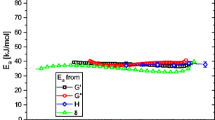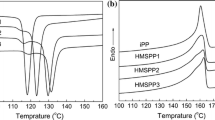Abstract
Despite substantial progress in analytical techniques for polymer characterization, a realistic picture of branching structure in industrial polymers still remains at large. Using a number of assumptions, structure-based constitutive models can distinguish between linear and branched structures in a qualitative sense. More detail on branching architecture, such as the number and length of side chains, the sequence in which they exist on the backbone and their contribution to polymer chain relaxation is more or less unknown. In the current study, elongational behavior of four commercial polyolefins is compared using the predictions of the MSF (molecular stress function) theory. The results will then be used to analyze the branching in a group of strain-hardening polypropylenes synthesized using single site catalyst.








Similar content being viewed by others
References
Field GJ, Micic P, Bhattacharya SN. Melt strength and film bubble instability of LLDPE/LDPE blends. Polym Int. 1999;48:461–6.
Lohse DJ, Milner ST, Fetters LJ, Xenidou M, Hadjichristidis N, Mendelson RA, et al. Well-defined, model long-chain branched polyethylene. 2. Melt rheological behavior. Macromolecules. 2002;35:3066–75.
Hussein IA. Influence of composition distribution and branch content on the miscibility of m-LLDPE and HDPE blends: rheological investigation. Macromolecules. 2003;36:2024–31.
Stephens CH, Hiltner A, Baer E. Phase behavior of partially miscible blends of linear and branched polyethylenes. Macromolecules. 2003;36:2733–41.
Mieda N, Yamaguchi M. Anomalous rheological response for binary blends of linear polyethylene and long chain-branched polyethylene. Adv Polym Tech. 2008;26:173–81.
Liu C, Wang J, He J. Rheological and thermal properties of m-LLDPE blends with m-HDPE and LDPE. Polymer. 2002;43:3811–8.
Stadlbauer M, Ernst E. Polypropylene foam. European Patent 2008; EP1900764A1.
Rätzsch M, Hesse A, Bucka H, Reichelt N, Panzer U, Bühler K. Polyolefinschaumstoffe hoher Wärmeformbeständigkeit. European Patent 1998; EP0879844A1.
Stadlbauer M, Kirchberger M. A polyolefin foam. European Patent 2007; EP1754744A1.
Stadlbauer M, Kirchberger M, Ernst E. Extrusion coated substrate. European Patent 2008; EP1967547A1.
Hesse A, Panzer U, Paulik C, Wolfsberger A, Kirchberger M, Niedersüss P. Polyolefinfolien und Polyolefinbeschichtungen von Substraten. European Patent 1999; EP0947551A1.
Stadlbauer M, Ernst E, Niedersüss P. Blown film of polypropylene. European Patent 2008; EP1903070A1.
Ernst E, Stadlbauer M. Multi-branched polypropylene. European Patent EP 2007; 1847555.
de Gennes PG. Reptation of polymer chains in presence of fixed obstacles. J Chem Phys. 1971;55:572–9.
Doi M, Edwards SF. Theory of polymer dynamics. Oxford: Oxford University Press; 1986.
Tsenoglou C. Molecular weight polydispersity effects on the viscoelasticity of entangled linear polymers. Macromolecules. 1991;24:1762–7.
van Ruymbeke E, Keunings R, Stéphenne V, Hagenaars A, Bailly C. Evaluation of reptation models for predicting the linear viscoelastic properties of linear entangled polymers. Macromolecules. 2002;35:2689–99.
Hepperle J, Münstedt H, Haug PK, Eisenbach D. Rheological properties of branched polystyrenes: linear viscoelastic behavior. Rheol Acta. 2005;45:151–63.
Urakawa O, Takahashi M, Masuda T, Golshan Ebrahimi N. Damping functions and chain relaxation in uniaxial and biaxial elongation: comparison with the Doi-Edwards theory. Macromolecules. 1995;28:7196–201.
Pearson DS, Kiss AD, Fetters LJ, Doi M. Flow-induced birefringence of concentrated polyisoprene solutions. J Rheol. 1989;33:517–35.
Ianniruberto G, Marrucci G. A simple constitutive equation for entangled polymers with chain stretch. J Rheol. 2001;45:1305–18.
Fang G, Kröger M, Öttinger HC. A thermodynamically admissible reptation model for fast flows of entangled polymers. II. Model predictions for shear and extensional flow. J Rheol. 2000;44:1293–317.
Mead DW, Larson RG, Doi M. A molecular theory for fast flows of entangled polymers. Macromolecules. 1998;31:7895–914.
Wagner MH, Stephenson SE. The irreversibility assumption of network disentanglement in flowing polymer melts and its effects on elastic recoil predictions. J Rheol. 1979;23:489–504.
Wagner MH. The nonlinear strain measure of polyisobutylene melt in general biaxial flow and its comparison to the Doi-Edwards model. Rheol Acta. 1990;29:594–603.
Marrucci G, de Cindio B. The stress relaxation of molten PMMA. Rheol Acta. 1980;19:68–75.
Wagner MH, Rubio P, Bastian H. The molecular stress function model for polydisperse and polymer melts with dissipative convective constraint release. J Rheol. 2001;45:1387–412.
Marrucci G, Grizzutti N. The free energy function of the Doi-Edwards theory: analysis of instabilities in stress relaxation. J Rheol. 1983;27:433–50.
Wagner MH, Bastian H, Hachmann P, Meissner J, Kurzbeck S, Languche F. The strain hardening behaviour of linear and long-chain-branched polyolefin melts. Rheol Acta. 2000;39:97–109.
Wagner MH, Yamaguchi M, Takahashi M. Quantitative assessment of strain hardening of LDPE melts by MSF model. J Rheol. 2003;47:779–93.
Wagner MH, Hepperle J, Münstdet H. Relating molecular structure of model branched polystyrene melts to strain-hardening by molecular stress function theory. J Rheol. 2004;48:489–503.
Ohnishi R, Fujimura T, Tsunori R, Sugita Y. A new method for producing high melt strength poly(propylene) with reactive extrusion. Macromol Mater Eng. 2005;290:1127–234.
Auhl D, Stange J, Münstedt H, Krause B, Voigt D, Lederer A, et al. Long-chain branched polypropylenes by electron beam irradiation and their properties. Macromolecules. 2004;37:9465–72.
Wagner MH, Kheirandish S, Yamaguchi M. Quantitative analysis of melt elongational behavior of LDPE/LLDPE blends. Rheol Acta. 2005;44:198–218.
Münstedt H, Kurzbeck S, Stange J. Importance of elongational properties of polymer melts for film blowing and thermoforming. 2006;46:1190–5.
Sadeghi F, Ajji A, Carreau PJ. Analysis of row nucleated lamellar morphology of polypropylene obtained from the cast film process: effect of melt and process conditions. Polym Eng Sci. 2007;47:1170–8.
Sadeghi F, Ajji A, Carreau PJ. Microporous membranes obtained from polypropylene blends superior with permeability properties. J Polym Sci B Polym Phys. 2008;46:148–57.
Stadler FJ, Nishioka A, Stange J, Koyama K, Mpünstedt H. Comparison of the elongational behavior of various polyolefins in uniaxial and equibiaxial flows. Rheol Acta. 2007;46:1003–12.
Rätzsch M, Bucka H, Hesse A, Panzer U, Reichelt N. Strukturisomere Poly(alkylethylene). European Patent 1997; EP0787750A2.
Wagner MH, Kheirandish S, Stange J, Münstedt H. Modeling elongational viscosity of blends of linear and long-chain branched polypropylenes. 2006;46:211–22.
Wagner MH, Kheirandish S, Koyama K, Nishioka A, Minegishi A, Takahashi T. Modeling strain hardening of polydisperse polystyrene melts by molecular stress function theory. Rheol Acta. 2005;44:235–43.
Author information
Authors and Affiliations
Corresponding author
Additional information
Dedicated to Professor Manfred H. Wagner on the occasion of his 60th birthday
Rights and permissions
About this article
Cite this article
Kheirandish, S., Stadlbauer, M. Molecular stress function theory and analysis of branching structure in industrial polyolefins. J Therm Anal Calorim 98, 629–637 (2009). https://doi.org/10.1007/s10973-009-0507-4
Published:
Issue Date:
DOI: https://doi.org/10.1007/s10973-009-0507-4




